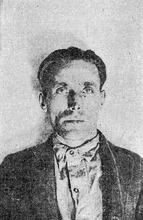This is an archived article that was published on sltrib.com in 2011, and information in the article may be outdated. It is provided only for personal research purposes and may not be reprinted.
The last time Utah executed a cartoonist, he was probably innocent.
Joe Hill is best known today for being the labor activist and songster who was executed by the state of Utah in 1915. William Adler's just-released book, The Man Who Never Died: The Life, Times, and Legacy of Joe Hill, makes a convincing case that Utah got the wrong man. This is personally gratifying; Hill was a political cartoonist.
Hill was executed for murdering a Salt Lake City grocer in an attempted robbery — a robbery where nothing was taken from the 800 South West Temple store. He fit the physical description of the man who murdered grocer John Morrison and his son, Arling. But so did another man who had a history of violence and was later to take part in the Chicago St. Valentine's Day Massacre.
Magnus Olson, aka Madmus Morton, aka Magnus Morgan, aka Frank Z. Wilson, aka James Franklin, aka James Franklyn, aka James Farmer, aka Harry Fuller, aka ... (there are at least 16 aliases) was fresh from a bout of mayhem in Nevada when police picked him up on the street in front of the murdered grocer's store hours after the killing.
Ignorant of Olson's past or identity, he was let go a few days later. Police were certain they had a better suspect in Joe Hill.
Hill immigrated to America from Sweden in 1902. His quick command of English is on full display in his letters, songs and cartoons. In less than a decade he not only knew English, he was having fun with it. The phrase "pie in the sky" comes from one of his songs mocking religious hypocrisy.
Hill sent personal cartoons to his friends, affectionately tweaking them in sketches, recalling faces and places from memory. His more scathing cartoons, depictions of the powerful abusing the powerless, appeared in The Industrial Worker, the official publication of the Industrial Workers of the World.
The IWW was the "Continental Congress of the Working Class," as the union's founding father, Utahn Bill Haywood, styled it. For a time, the IWW was an impressive power in American labor.
While his cartoons were certainly the work of a gifted satirist, Hill's songs truly shine. Set to hymns and popular tunes, his lyrics still scald:
We're spending billions every year,
For guns and ammunition,
"Our Army" and "Our Navy" dear
To keep in good condition;
While millions live in misery
And millions die before us . . .
Exuberantly sung in the street, on the shop floor and in the jails, Hill's songs posed a problem for the anti-union establishment. Familiar with breaking strikes and bones with nightsticks, it didn't know how to deal with the singing.
Intelligence, drive and wit should have taken Hill far in the Land of Opportunity. Instead, on Nov. 15, 1915, he faced a Utah firing squad.
Hill's first mistake was to own a brand new hole in his chest the same evening the grocer Morrison and son were killed. Morrison's son may, or may not, have got a shot off at his murderer.
Hill's second mistake was to be an immigrant at the turn of the 20th century, when alarmists warned that America was drowning in foreigners. It's hard to fathom now, but even newcomers from Scandinavia were caricatured as undesirable dimwits. They were called squareheads.
Hill's third mistake was to irritate the Utah establishment. The "gentile" silver barons had as little use for Hill's rabble-rousing as did their erstwhile antagonists, LDS Church officials who had a fetish for order. With the entire state bent on his destruction, it is no wonder that Hill asked that his body be taken to the state line, as he "didn't want to be caught dead in Utah."
His last mistake was to assume that the U.S. legal system wouldn't kill an innocent man. When he stumbled into the Murray doctor's home with a bullet wound, he mentioned a fight over a woman. At trial, he refused to offer specifics of how he came by his telltale wound, like the name of the woman. He staunchly maintained there was no direct evidence to tie him to the murder since he hadn't done it.
Until Adler's 2011 book, there were enough troubling aspects to the story that even some of Hill's admirers and biographers allowed that he could have killed Morrison. Adler has produced a fully realized picture of the man, but also a gripping detective story that comes close to exonerating Hill. Adler's discovery of the 1949 letter from Hilda Erickson, which states Hill was shot in a romantic dispute over her, made national news last month. But Adler deserves credit for turning up enough new material on Olson to indict him as the likely killer.
I was pleased to find in Adler's book a kindred spirit and not a killer. Hill's wish was posthumously granted. His body was shipped out of state to Chicago where 30,000 turned out for his funeral.
Pat Bagley is the editorial cartoonist for The Salt Lake Tribune. —
A Joe Hill archive
To see portraits of Joe Hill, samplings of his artwork and political cartoons, and a photograph from his funeral, visit the website of the Walter P. Reuther Library, Wayne State University, at http://bit.ly/pz5FlP.



